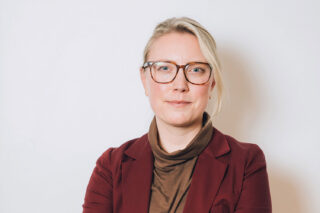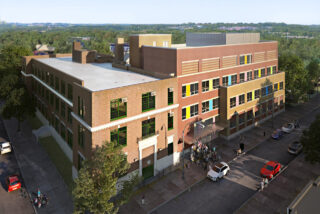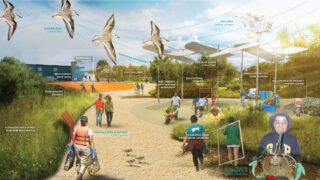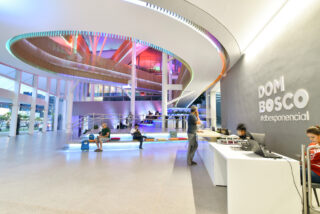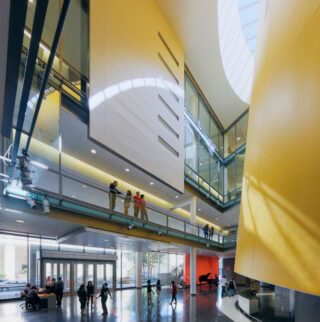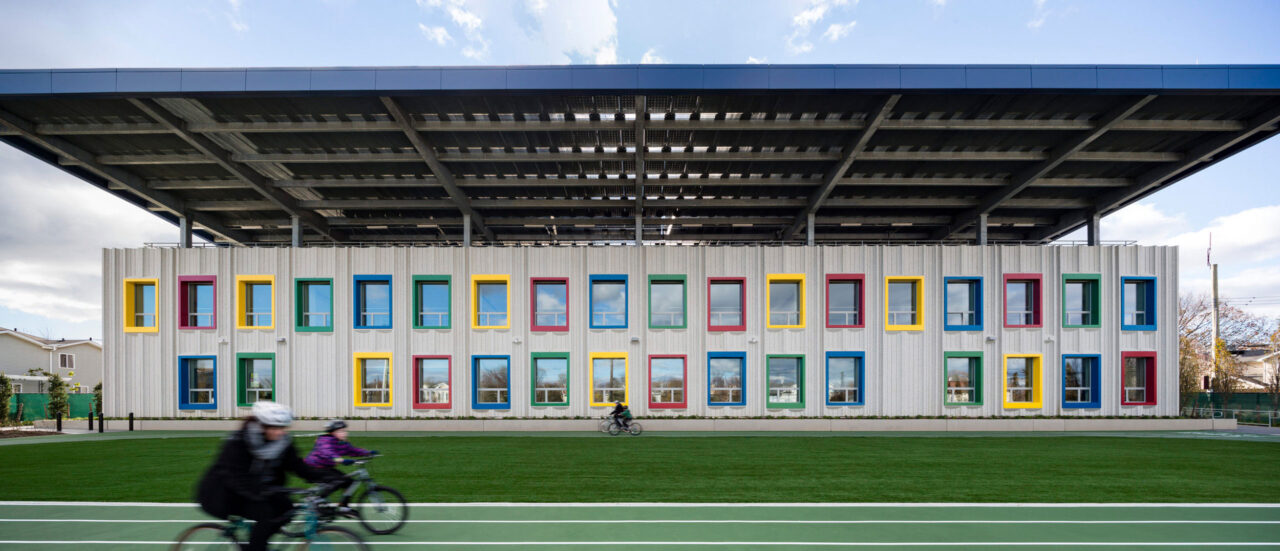
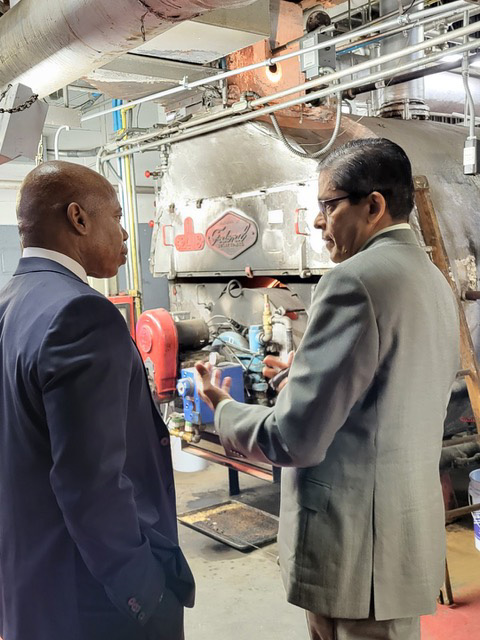
If converting a single building from reliance on fossil fuels to electric power is a victory, at least on a proof-of-concept scale, does converting 100 such buildings nudge that achievement up toward the level of a sea change? New York’s School Construction Authority (SCA), the special public entity the state legislature created in 1988 to design, build, and renovate the city’s public schools, will soon discover the scope of its influence within and beyond its niche in the local built environment.
City government has been systematically greening its facilities and operations for most of the past two decades under Local Law 97, the current strategic plan “PlaNYC: Getting Sustainability Done,” its predecessor “One NYC 2050,” and the original “PlaNYC” in 2007. The latest initiative “Leading the Charge,” a $4 billion effort announced last October 28 by Mayor Eric Adams, now joins that series of programs, address-ing several overlapping goals: reducing greenhouse gas emissions toward the goal of carbon neutrality by 2050, redressing longstanding environmental injustices, expanding the city’s green workforce, and improving both neighborhood air quality and students’ learning atmospheres.
Along with converting 100 existing schools throughout the five boroughs to all-electric heating by 2030, the new plan calls for electric heating in all new school construction; phases out No. 4 heating oil, the dirtiest still in use, by 2026, faster than the legal mandate requires; and installs LED lights in 800 schools by 2026. Between its retrofitting measures and its effects on new buildings, the new plan is the nation’s largest school-electrification program, augmenting New York City’s pioneer position among jurisdictions embracing the decarbonized future.
“New York City schools have a pretty ambitious greenhouse gas reduction goal: 60% from our 2006 baseline, which is 485,000 metric tons of CO2,” says Nina Kubota, president and CEO of the SCA. “When we are done with this electrification of the first 100 buildings, we expect to reduce greenhouse gas emissions by 120,000 tons annually and remove over 20,000 pounds of harmful, disease-causing fine particulates from the air—the equivalent of removing 26,000 cars from the city.”
The Department of Education (DOE) has a total portfolio of about 1,400 schools. “We bring on about 15 to 20 buildings per year,” adds Kubota, “built where there is need for new capac-ity into our system.” The new plan expands on SCA’s previous environmental achievements, including construction of a Net Zero primary school in 2015 (the Kathleen Grimm School for Leadership and Sustainability on Staten Island, designed by SOM) and the opening of the system’s first fully electric school (PS 5 in Bedford-Stuyvesant, Brooklyn) last September. Another area of progress, she notes, involves stand-alone gyms; these are approximately 4,000-square-foot gymnasium struc-tures built in the yards adjacent to schools that didn’t previously have a gym. “We’ve built about 20 of them, and over half are fully electric,“ says Kubota.


The list of 100 schools to be retrofitted is still being determined. “We are prioritizing the environmental justice areas,” Kubota says, recognizing that underprivileged neighborhoods have historically borne more than their share of pollutants. SCA’s chief design and construction innovation officer, Stanley Dahir, a 30-year veteran in school architecture, notes that other selection criteria include assessment of existing fuel use (No. 4 oil, No. 2 oil, or gas, in decreasing order of pollution severity), the condition of current building envelopes and boilers, and any recent changes to a building that affect its energy performance.
In adding sophisticated new systems to older schools, Dahir says, “There is going to be some modification to the fenestration of the building; typically, we try to limit it to the windows, maybe having to take out a sash in the winter and replace it with a louver. We’re trying to be very respectful of these old historic buildings,” which are “obviously not the most energy-efficient to begin with.”
The usual procedure, says SCA Managing Engineer Deoraj Persaud, is to remove antiquated fossil-fuel-burning boilers and storage tanks, replacing them with electric heat pumps that need more electrical service. A typical project might upgrade from 1,200-amp service to 6,000-amp, requiring coordination with the utility on retaining or replacing a property-line box, including switchover procedures when an electrical room is expanded during continuous operation. Temporary boilers and tanks housed in trailers parked in front of schools, as used in previous upgrades, are not needed in electrification procedures, Persaud adds. “We actually keep the existing boilers operating while we take a few classrooms, convert those, and then keep alternating and move them on, so the temporary boiler is no longer required; the pollution that that generates is no longer there.” Swapping out boilers for contemporary equipment also involves multisystem strategic planning, including redundant capacity to accommodate climatic extremes, swing spaces to keep schools operating during installation, Americans with Disabilities Act compliance, fire alarms, and structural reinforcement of cinder concrete buildings to support the equipment’s weight.
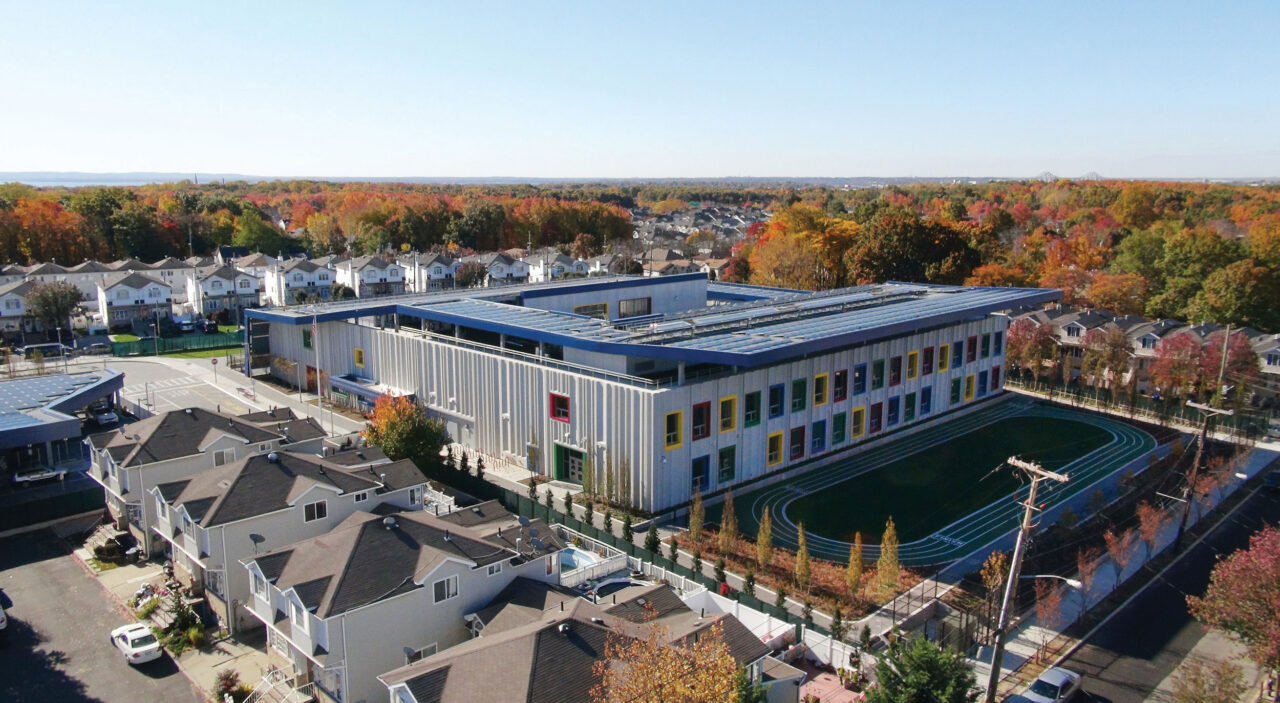
The conversions use two basic systems: an in-room unit that gives good local control but takes up space inside rooms, and a centralized system installed elsewhere in a building, often on rooftops. SCA is not the only agency interested in that space; the Board of Education has a program to add photovoltaics (PVs) to certain buildings, and the Department of Environmental Protection is exploring green roofs to manage stormwater loads. “Everybody’s challenge is to get on our roofs and use the roof space for something,” Dahir says. “We do coordinate and, obviously, we don’t want to be working in buildings where they’re putting in PVs.” SCA’s systems draw power from the grid rather than from local generation, as seen in the Net Zero school on Staten Island, where PVs mounted on a parking structure power the HVAC. Another benefit that Persaud emphasizes is improved interior environmental quality. Many old schools have heating but no cooling, and “the antiquated ventilation system is really just an exhaust fan,” comparable to windows alone. “With this new electrification,” says Persaud, “they’d be having heating, cooling, and ventilation, in addition to having super-filtrated air.”
The average age of the city’s school buildings is 75, and 200 of them have entered their second century, which means the electrification plan requires consultation with the State Historic Preservation Office to respect the schools’ architectural character. Another complication is that the work must be done in fully or partially occupied buildings; work proceeds after school hours, from 4pm (or later in schools with evening programs) to around 11pm or midnight, so crews do not disturb students. “The idea is they’re not going to see us,” Kubota notes. “We want to make it as minimally disruptive as possible. We operate around the school’s operations, not the other way around.” “A lot of what we do, whether it’s green roofs or PVs, there’s always an educational component to it,” she continues. DOE’s Office of Sustainability treats school electrification and other greening efforts as teaching opportunities as well as performance upgrades. This form of education is not limited to the students. “We’ve really pushed the industry in the design of these systems,” Dahir says, with “robust specs” that firms strive to meet. SCA’s engineers and architects sit on the city’s code committees, contributing a perspective that helps contractors get up to speed and manufacturers get up to scale. Kubota cites heat pumps in particular, a product previously geared more to smaller spaces: “We obviously have larger public-assembly spaces—our auditoriums, our gymnasiums—that these small residential units would not be able to serve. So we’ve already pushed the industry to start producing those types of units for basically our purpose.”
An organization with as large a profile as SCA’s can have considerable sway as the relevant industries evolve. How its transformations might scale up nationally—including in locations where the electrical grid itself has a troublesome emissions profile—is a conversation for another day.
BILL MILLARD contributes regularly to Oculus, the Architect’s Newspaper, Metals in Construction, Annals of Emergency Medicine, and other publications. His book The Vertical and Horizontal Americas, assisted by a Graham Foundation grant, moves glacially forward.









